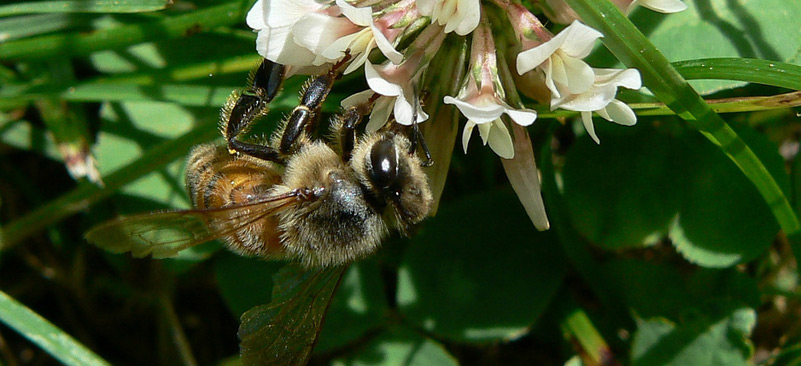 Le api: Chi sono le api
Le api: Chi sono le api |
Il ruolo dell'ape in natura
Beehive: Beehive |
Swarming |
Pollination |
Morphology and anatomy |
Diseases
Diseases
Varroa
Varroa is a genus of parasitic mites associated with honey bees, placed in its own family, Varroidae. The genus was named for Marcus Terentius Varro, a Roman scholar who was also a beekeeper.
American foulbrood
American foulbrood (AFB), caused by the spore- forming Paenibacillus larvae ssp. larvae (formerly classified as Bacillus larvae), is the most widespread and destructive of the bee brood diseases. Paenibacillus larvae is a rod-shaped bacterium, which is visible only under a high power microscope. Larvae up to 3 days old become infected by ingesting spores that are present in their food. Young larvae less than 24 hours old are most susceptible to infection. Spores germinate in the gut of the larva and the vegetative form of the bacteria begins to grow, taking its nourishment from the larva. Spores will not germinate in larvae over 3 days old. Infected larvae normally die after their cell is sealed. The vegetative form of the bacterium will die but not before it produces many millions of spores. Each dead larva may contain as many as 100 million spores. This disease only affects the bee larvae but is highly infectious and deadly to bee brood. Infected larvae darken and die.
European foulbrood
Melissococcus plutonius is a bacterium that infests the mid-gut of an infected bee larva. European foulbrood is less deadly to a colony than American foulbrood. Melissococcus plutonius does not form spores, though it can overwinter on comb. Symptoms include dead and dying larvae which can appear curled upwards, brown or yellow, melted or deflated with tracheal tubes more apparent, and/or dried out and rubbery.
European foulbrood is often considered a "stress" disease—a disease that is dangerous only if the colony is already under stress for other reasons. An otherwise healthy colony can usually survive European foulbrood. An outbreak of the disease may be controlled chemically with oxytetracycline hydrochloride, but honey from treated colonies could have chemical residues from the treatment. The 'Shook Swarm'[clarification needed] technique of bee husbandry can also be used to effectively control the disease, the advantage being that chemicals are not used. Prophylactic treatments are not recommended as they lead to resistant bacteria.
Nosema
Nosema apis is a microsporidian that invades the intestinal tracts of adult bees and causes nosema disease, also known as nosemosis. Nosema is also associated with Black queen-cell virus. Nosema is normally only a problem when the bees can not leave the hive to eliminate waste (for example, during an extended cold spell in winter or when the hives are enclosed in a wintering barn). When the bees are unable to void (cleansing flights), they can develop dysentery.
Mycosis
Mycosis (plural: Mycoses) is a condition in which fungi pass the resistance barriers of the human or animal body and establish infections
Wax moths
Galleria mellonella (greater wax moths) will not attack the bees directly, but feed on the wax used by the bees to build their honeycomb. Their full development to adults requires access to used brood comb or brood cell cleanings—these contain protein essential for the larvae's development, in the form of brood cocoons.
Small hive beetle
The small hive beetle (Aethina tumida) is a beekeeping pest.
Colony collapse disorder (CCD)
Colony collapse disorder (CCD) is a phenomenon in which worker bees from a beehive or European honey bee colony abruptly disappear. While such disappearances have occurred throughout the history of apiculture, the term colony collapse disorder was first applied to a drastic rise in the number of disappearances of Western honey bee colonies in North America in late 2006. Colony collapse is significant because many agricultural crops worldwide are pollinated by bees.
European beekeepers observed similar phenomena in Belgium, France, the Netherlands, Greece, Italy, Portugal, and Spain, and initial reports have also come in from Switzerland and Germany, albeit to a lesser degree while the Northern Ireland Assembly received reports of a decline greater than 50%. Possible cases of CCD have also been reported in Taiwan since April 2007.
The cause or causes of the syndrome are not yet fully understood. In 2007 some authorities attributed the problem to biotic factors such as Varroa mites and insect diseases. Other proposed causes include environmental change-related stresses, malnutrition, pesticides, and migratory beekeeping. More speculative possibilities have included both cell phone radiation and genetically modified (GM) crops with pest control characteristics, though no evidence exists for either assertion. It has also been suggested that it may be due to a combination of many factors and that no single factor is the cause. The most recent report (USDA - 2010) states that "based on an initial analysis of collected bee samples (CCD- and non-CCD affected), reports have noted the high number of viruses and other pathogens, pesticides, and parasites present in CCD colonies, and lower levels in non-CCD colonies. This work suggests that a combination of environmental stressors may set off a cascade of events and contribute to a colony where weakened worker bees are more susceptible to pests and pathogens."
Applying proteomics-based pathogen screening tools in 2010, researchers announced they had identified a co-infection of invertebrate iridescent virus type 6 and Nosema ceranae in all CCD colonies sampled. The study is the first to conclude that co-factors, the virus and fungus, were present in all of the collapsed colonies studied. However, scientists in the project emphasize additional research is still needed to consider how environmental factors like temperatures, drought and pesticides might play a role, if any, in CCD.

